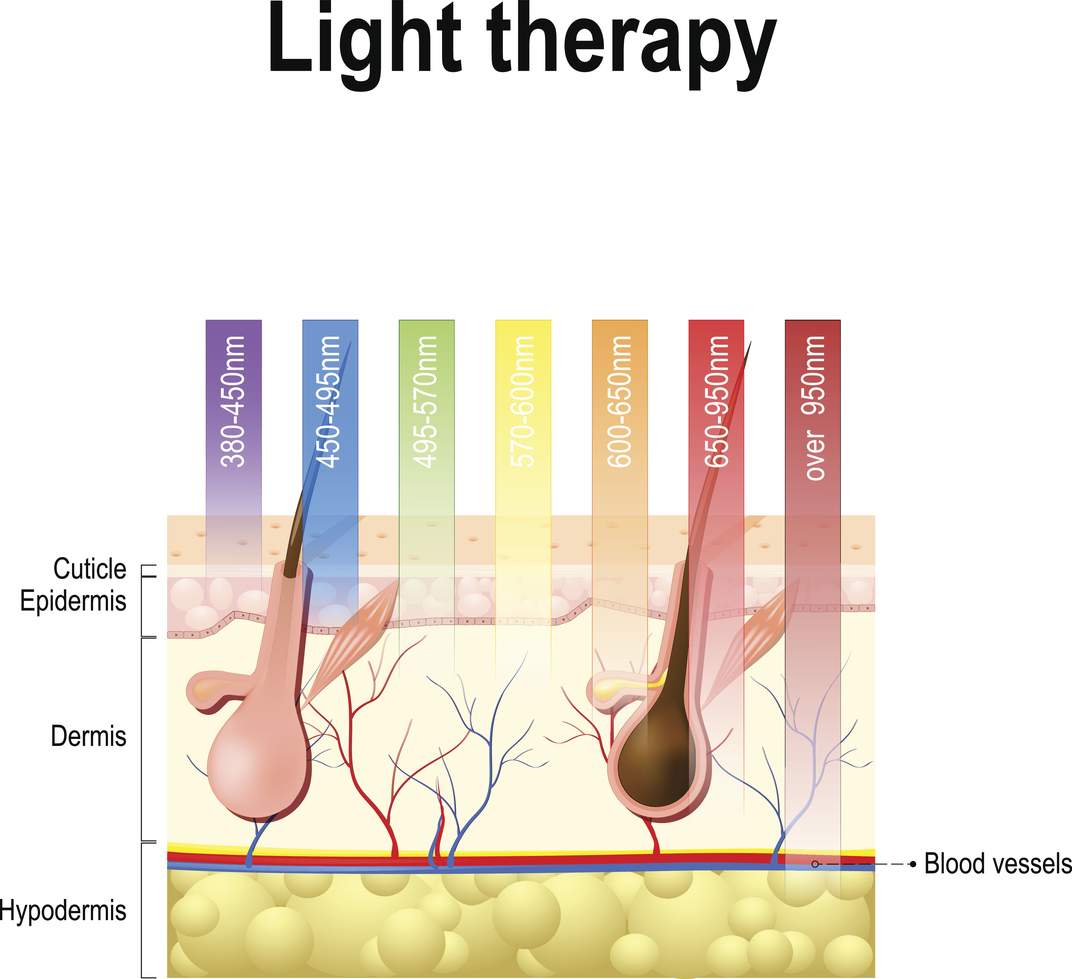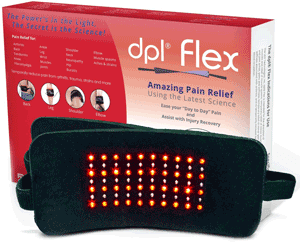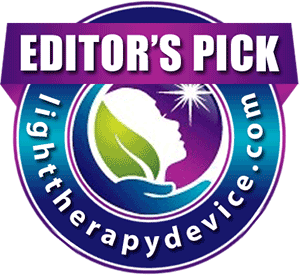
Table of Contents
- 1 What is LED Light Therapy?
- 2 What is the origin of LED light therapy?
- 3 Why are there different colors of LED lights used during therapy?
- 4 What are the benefits of the different light wavelengths?
- 5 How deep does the light penetrate?
- 6 Where can LED light therapy be used?
- 7 What’s the best wavelength for Anti-Aging?
- 8 How often must you undergo LED treatments?
- 9 How long are LED light therapy sessions?
- 10 Does LED light therapy have side effects?
- 11 Where can I get LED light therapy?
- 12 What are the types of in-home LED light therapy devices?
What is LED Light Therapy?
The acronym LED means light emitting diode. The LED lights are miniature bulbs inserted into fixtures that provide the light therapy. While traditional bulbs contain a filament that produces light, LED bulbs contain semiconducting diodes that interact with electrons to produce light in specific colors or wavelengths without emitting heat. The light penetrates into the skin and subcutaneous tissues and converts into energy that causes a number of beneficial biological effects.
What is the origin of LED light therapy?
NASA scientists were the first to uncover the therapeutic properties of LED light. Plants placed under certain light colors were able to achieve photosynthesis faster, which impacted growth and health. LED lights also proved useful for hastening the healing of wounds that astronauts might suffer while in space. Due to the findings published by NASA, other scientists performed studies of LED light therapy and found similar results. The lights have since become part of medical and esthetic treatments.
Why are there different colors of LED lights used during therapy?
The LED bulbs are designed to emit light in different colors, which represent different wavelengths on the light spectrum. Each wavelength penetrates the skin at a specific depth to provide unique benefits.
What are the benefits of the different light wavelengths?
The most common LED light therapy colors and wavelengths are as follows:
- Near-infrared light is not visible and emits energy at a range of between 810 and 830 nanometers or nm. Near-infrared light penetrates the skin and converts into energy to improve blood circulation and cellular replication in specific areas. Cellular mitochondria are better able to produce energy for necessary cell functions and repair. Thus, the wavelength is often used to relieve muscle and connective tissue pain. The LED therapy also hastens the healing of ligament and muscle sprains, strains and wound healing.
- Red LED bulbs emit light at between 620 and 700 nm. Red light therapy also increases blood and lymph circulation in the region where the light is directed. In this way, the lights are used to speed healing as the therapy reduces inflammation and relieves pain.
- Blue LED bulbs emit light at frequencies of between 400 and 495 nm. The wavelength is especially useful for killing the bacteria that leads to acne. The frequency also reduces inflammation.
- Green LED bulbs illuminate at frequencies of between 515 and 520 nm. They are designed to even out skin tones in areas exhibiting hyper-pigmentation. Green light therapy is also recommended for fading other types of discolorations or spots.
- Amber or Yellow LED bulbs emit light in the 570 to the 600 nm range. Amber light is used to minimize redness and soothe skin. The frequency is also helpful in decreasing the appearance of spider veins.
- Purple, violet or ultraviolet light is found below the 380 nm frequency. The wavelength is widely reputed for having antimicrobial properties. Purple light also encourages new cell formation.
Some devices combine near infrared and red LED lights or red and blue LED lights in order to achieve the benefits of both wavelengths simultaneously.
How deep does the light penetrate?
The penetration ability of each wavelength is as follows:
- Near-infrared-10 mm or 0.39 of an inch
- Red-3 mm or one-tenth of an inch
- Yellow or amber-2 mm or 0.07 of an inch
- Blue-1 mm or 0.03 of an inch
Where can LED light therapy be used?
LED light therapy at any wavelength is safe to use on any topical region of the body. However, under most cases, protective goggles are typically recommended to prevent direct eye exposure.
What’s the best wavelength for Anti-Aging?
Near-infrared and red LED light therapy is the most highly recommended for rejuvenating skin. At these wavelengths, the light encourages collagen and fibrin production in order to plump the skin, which helps alleviate fine lines and wrinkles. The frequency is also helpful for minimizing scarring.
How often must you undergo LED treatments?
Treatments are generally recommended two or three times each week. The number of weeks needed to achieve the desired effect depends on individual circumstances. However, the majority of people see results in four to six weeks. To maintain the effects, treatments are usually provided once every one or two weeks thereafter.
How long are LED light therapy sessions?
When first starting treatment, the skin should not be exposed to the light for more than five minutes. In time, treatment sessions are gradually increased for a length of up to 15 minutes.
Does LED light therapy have side effects?
LED light therapy is painless. However, initially, the skin may become slightly reddened until accustomed to treatment. The side effect typically subsides within one hour after treatment. The skin might also seem drier, which necessitates using a moisturizer. The best part of getting LED light therapy treatments includes the fact that you can resume daily activities without having to endure recovery times.
Where can I get LED light therapy?
Dermatologists and medical spas offer LED light therapy for medical or cosmetic reasons. However, before undergoing treatment, individuals should ensure that the therapy is provided by a licensed physician or a trained and certified technician. There are also an array of devices available for in-home use by the consumer.
What are the types of in-home LED light therapy devices?
Consumers may choose from a large selection of LED light therapy devices that come in a wide range of prices. Some devices resemble handheld shower heads complete with one wavelength of LED lights for facial treatments. They can also be used on other body areas. There are tabletop panels containing LED lights that are also used for various body regions. When desiring a device merely to obtain facial treatments, masks resembling gear worn by hockey goalies are ideal. The masks also typically are equipped with LED bulbs that enable the user to choose from three to six different wavelengths to obtain a combination of benefits. Some devices are manufactured specifically to enjoy foot treatments or to cover larger areas that may include areas along the back.


